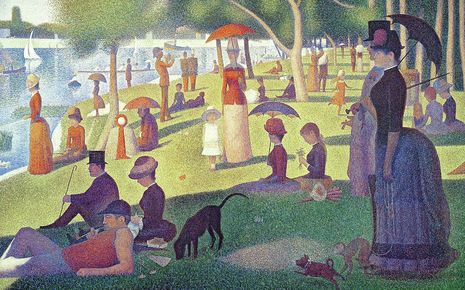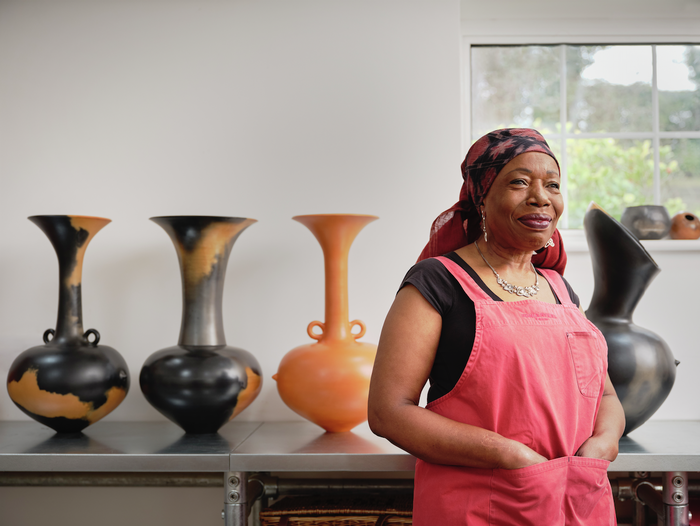“A view from Zagreb: Op Art and Kinetic Art” in the Tate Modern
Margaux Emmanuel takes us to the Tate Modern; her second piece of arts criticism focuses on a permanent display titled ‘A view from Zagreb: Op Art and Kinetic Art’
London, November. The city: in motion – never-stopping, never-ending, a pulsating artery, a breathing lung. Colours, flashing: late buses, cars whizzing by, with their flashing lights and blended colours.
The buildings around the Tate Modern are slick, modern and piercing – the dark night around the skyscrapers seems to move around their pointy angles. In the museum’s permanent display titled ‘A view from Zagreb: Op Art and Kinetic Art’ in Studio 12, a selection curated by Valentina Ravaglia, negative spaces are kinetic, in motion. This exhibition is centred around the New Tendencies group, founded in 1961 in Zagreb, Croatia. The geometrical precision of the angles and cuts deviates from a positivist approach, as the logical systems on which the works seem to rely on become unstable. The layering of tinted blue plastic in ‘Indefinite Spaces S’ (1963) by Francisco Sobrino creates this perceptive instability for the viewer; I stand there, looking at the oeuvre – somebody behind me walks by, and the colours oscillate with their fleeting reflection. Spaces are assembled only to be unassembled in the passerby’s mind, as the relationship between the sheets of plastic becomes uncertain.
Sobrino, a Spanish artist, joined the Argentinian movement of Arte Concreto-Invención in Buenos Aires – which focused on geometrical abstraction through the use of Concrete Art. This movement was in the context of a post-WWII world. This abstraction aligns itself with the purist aesthetics of Piet Mondrian and Theo van Doesburg, respectively with the famous ‘Composition with Red Blue and Yellow’, or ‘Contra-Construction Project’. Sobrino’s art, within this movement, strived for a sense of universality, an artistic objectivity diverging from the representational quality of naturalistic art. ‘Indefinite Spaces S’ also deals with the inaccessible of the trompe l’oeil–Sobrino’s work is like the Dantesque ‘… geometrician, who endeavours / To square the circle’ (Paradiso 33, ’Qual è ‘l geomètra che tutto s’affige / per misurar lo cerchio’) – these lines elicit a vision not fully accessible, as we can see with Dante’s paradox. Scientific rationality merges with the illusionary, creating a logic of impossibility and uncertainty.
Some photos from yesterday’s trip to the Tate.
- Elizabeth (@EALphotography) December 1, 2021
Carlos Cruz-Diez
Physichromie 113#tatemodern #art #exhibition #artist #photography pic.twitter.com/tG4it30Zsl
The idea of measuring the circle to square it is an idea quite literally enacted by the Venezuelan artist Carlos Cruz-Diez’s ‘Physichromie 113’ (1963, 1976): the artwork is made of strips, vertical bands, and stainless steel plates. In the middle of the vertical bands, a large circle can be made out in the middle. As you move around the work, multiple chromatic ranges appear, the circle either white or in darker shades. The neologism ‘physichromie’ derives from ‘physical chromatism’ – just like the London landscape, every angle offers another range of perception through its dynamism.
“Spaces are assembled only to be unassembled in the passerby’s mind, as the relationship between the sheets of plastic becomes uncertain”
The art historian Arnauld Pierre considers ‘Physichromie’ to be influenced by the French impressionist and post-impressionist movements that preceded him, with their use of ‘optical paintings’: ‘the network of fine lines of color plays a role in optical blending analogous to that of the pattern of little maculas which cover the surface of the works of Seurat and his followers’ (Optical Blends and Chromatic Instabilities: The Physichromies of Carlos Cruz-Diez), and writes on how the artist creates ‘lumino-chromatic phenomena’. Cruz-Diez’s works were influenced by the advances being made in science, particularly optical sciences and technologies in the 1960s.

The 1884 ‘A Sunday Afternoon on the Island of La Grande Jatte’ may seem worlds apart from ‘Physichromie 113’, but the pointillism and study of colour and perception confers a sense of movement, an illusion of movement, that anticipates the abstraction of Carlos Cruz-Diez’s oeuvre. The viewer’s experience of the oeuvre supersedes the material reality of it – anecdotally, ‘Physichromie’ itself was first made in the fragile material lumaline, then re-constructed in 1976 after its deterioration.
This interest in mathematical precision is furthered with Jean-Pierre Yvaral’s acrylic painting ‘Ambiguous Structure No. 92’. Light and dark purple, three-dimensional quadrants create a sense of relief, ‘kinetic relief’, with this grid. The warmer orange and red-ish tones get lighter towards the centre, the two different ranges of colour making a foreground and background. Knowing this, it does not come as a surprise to learn that Yvaral wanted to come up with a language of abstraction, an ‘alphabet plastique’, a way to hierarchise shape and colour. These artists were preoccupied with exploring the relationship between viewer and artist mediated through colour and movement, not only in the way they interrelate, but in how colour can be physical, or experienced in its physicality.
John Berger in Ways of Seeing (1972) wrote ’images were first made to conjure up the appearances of something that was absent. Gradually it became evident that an image could outlast what it represented; it then showed how something or somebody had once looked– and thus by implication how the subject had once been seen by other people.’ The subjects of Sobrino, Cruz-Diez and Pierre Yvaral’s works interact with the notion of ‘be[ing] seen’: in the midst of London, the art of this exposition surpasses their mere frames, making us pay more attention to the the dynamism of the hues and tones of the city around us. Colour becomes movement; being seen becomes seeing.
More information about the display can be found here: https://www.tate.org.uk/visit/tate-modern/display/in-the-studio/view-zagreb-op-and-kinetic-art
 News / SU stops offering student discounts8 January 2026
News / SU stops offering student discounts8 January 2026 News / Uni-linked firms rank among Cambridgeshire’s largest7 January 2026
News / Uni-linked firms rank among Cambridgeshire’s largest7 January 2026 Comment / Plastic pubs: the problem with Cambridge alehouses 5 January 2026
Comment / Plastic pubs: the problem with Cambridge alehouses 5 January 2026 News / New movement ‘Cambridge is Chopped’ launched to fight against hate crime7 January 2026
News / New movement ‘Cambridge is Chopped’ launched to fight against hate crime7 January 2026 Comment / What happened to men at Cambridge?31 December 2025
Comment / What happened to men at Cambridge?31 December 2025









